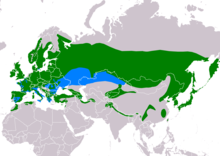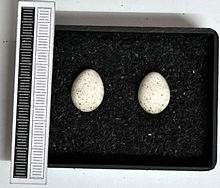Coal tit
| Coal tit | |
|---|---|

| |
| Adult British coal tit, P. a. britannicus (note greenish-grey back) | |
| Scientific classification | |
| Domain: | Eukaryota |
| Kingdom: | Animalia |
| Phylum: | Chordata |
| Class: | Aves |
| Order: | Passeriformes |
| Family: | Paridae |
| Genus: | Periparus |
| Species: | P. ater
|
| Binomial name | |
| Periparus ater | |

| |
| Range of P. ater Resident Non-breeding
| |
| Synonyms | |
|
Parus ater Linnaeus, 1758 | |
The coal tit or cole tit,.
Taxonomy and systematics
This species was first described by
Gessner also notes that the coal tit was known as Kohlmeiß in
Most authorities still treat the coal tit in the

In addition, the same data suggest that this species is
Subspecies
A number of coal tit
The
The North African race P. a. ledouci has yellow underparts and cheeks, and the Cypriot P. a. cypriotes has a buff tinge to its upper parts, and deep buff underparts. Asian subspecies are generally rather dusky brownish except for the black-and-white head;[8] they include among others P. a. michalowskii of the Caucasus, P. a. phaeonotus of Iran, or the Himalayan coal tit[10] P. a. aemodius of southwestern China.
-
Adult continental coal tit, P. a. ater
(note blue-grey back) -
Cyprus coal tit, P. a. cypriotes
(note buff underparts) -
Irish coal tit, P. a. hibernicus
(note yellowish cheeks and breast)
Description
The coal tit is 10–11.5 cm in length, and has a distinctive large white nape spot on its black head.
The young birds in juvenile plumage are duller than the adults, lacking gloss on the black head, and with the white of nape and cheeks tinged with yellow.[11]
While searching for food, coal tit flocks keep contact with incessant short dee or see-see calls. The species' song – if "song" it can be called – is a strident if-he, if-he, if-he, heard most frequently from January to June, but also in autumn. The song resembles that of the great tit, but much faster and higher in pitch.[12] One variant of this song ends with a sharp ichi. North African birds also have a currr call similar to that of the crested tit (Lophophanes cristatus) which is not found in Africa.
Behaviour and ecology

It is typically a bird of
The coal tit is an all-year resident throughout almost all range, making only local movements in response to particularly severe weather; only the
Coal tits will form small flocks in winter with other tits. This species resembles other tits in acrobatic skill and restless activity, though it more frequently pitches on a trunk, and in little hops resembles a
Coal tits in the laboratory prefer to forage at a variable feeding site when they are in a negative energy budget.[14] They increase evening body mass in response to tawny owl calls.[15] After dawn the coal tits increases body mass as soon as possible if food is obtained at a low rate, increasing body mass exponentially until an inflection point when the increase of body mass is slower.[16] The inflection point of the body mass trajectory is 16.7% delayed compared to a high food availability.[16] Subordinate coal tits are excluded from feeding sites by dominants more often in the early morning than in the rest of the day, and they showed more variability in daily mass gain and body mass at dawn than dominant coal tits.[17] In winter, the red blood cells of coal tits have been shown to contain more mitochondria, which consume oxygen and produce heat.[18][19]
Being common and widespread, the coal tit is not considered a
The coal tit has the dubious distinction of having the largest number of bird fleas (Ceratophyllus gallinae) reported from a single nest, 5,754 fleas.[21]
Breeding
A favourite nesting site is a hole in a rotting tree-stump, often low down, and the nest is deep within the hole; holes in the ground, burrows of
See also
- Common treecreeper and Hodgson's treecreeper
- Greenish warbler
Footnotes
- . Retrieved 19 November 2021.
- ^ "Cole tit". Oxford English Dictionary (Online ed.). Oxford University Press. (Subscription or participating institution membership required.)
- ^ Gessner (1555): pp.616, Linnaeus (1746, 1758)
- ISBN 978-1-4081-2501-4.
- iridescent), perhaps rather "wing-stripe tit", as in German ornithologySpiegel means a wing-stripe or -patch. The interpretation referring to its colorful plumage, though somewhat unusual, is the one given by Gesner however: a colorum pulchritudine quibus distinguitur – "for the beauty of its colors, which distinguish it"
- ^ Turner (1544a,b), Gessner (1555): pp.615–616, Frisch (1720[verification needed]), Linnaeus (1758)
- ^ a b Gill et al. (2005)
- ^ a b Snow (1954)
- ^ BI [2009]
- ^ Bangs (1932)
- ^ ISBN 978-83-7763-647-3.
- ISBN 89-951415-3-0
- ^ Inskipp et al. (2000)
- hdl:10261/43939. Archived from the original(PDF) on 20 December 2016. Retrieved 9 December 2016.
- S2CID 33198629. Archived from the original(PDF) on 20 December 2016. Retrieved 9 December 2016.
- ^ S2CID 53156385. Archived from the original(PDF) on 20 December 2016. Retrieved 12 December 2016.
- doi:10.1093/beheco/13.5.696. Archived from the original(PDF) on 20 December 2016. Retrieved 12 December 2016.
- ^ "Birds' blood functions as heating system in winter". phys.org. Retrieved 10 April 2021.
- S2CID 233185485.
- ^ BLI (2009)
- ISBN 978-90-474-2075-0.
References
- Field Mus. Nat. Hist. Zool. Ser. 18 (11): 343–379. Fulltext at the Internet Archive
- Bautista, L. M.; Martín, B.; Martinez, L.; Mayo, C. (2001). "Risk-sensitive foraging in coal tits" (PDF). Behaviour. 138: 69–83. hdl:10261/43939. Archived from the original(PDF) on 20 December 2016. Retrieved 9 December 2016.
- Bautista, L. M.; Lane, S.J. (2000). "Coal tits increase evening body mass in response to tawny owl calls" (PDF). Acta Ethologica. 2 (2): 105–110. S2CID 33198629. Archived from the original(PDF) on 20 December 2016. Retrieved 9 December 2016.
- BirdsIreland.com (BI) [2009]: Irish subspecies – Coal Tit. Retrieved 17 May 2009.
- .
- Frisch, Johann Leonhard (1720[verification needed]): Der II.ten Hauptart I.te Abtheilung von den Maisen – I.te Platte ["First division of the second primary species, the titmice – Plate 1"]. In: Vorstellung der Vögel in Teutschland, und beyläuffig auch einiger fremden, mit ihren natürlichen Farben, etc. (vol. 2): plate 13 [German with Latin and French captions]. F.H.Frisch, Berlin ("Berolinum"). Digitized version[permanent dead link]
- Historiae animalium (vol. 3) [Latin book]. Christoph Froschauer, Zürich ("Tigurium"). Digitized version
- Gill, Frank B.; Slikas, Beth & DOI: 10.1642/0004-8038(2005)122[0121:POTPIS]2.0.CO;2 HTML abstract
- Inskipp, Carol; Inskipp, Tim & Sherub (2000): The ornithological importance of Thrumshingla National Park, Bhutan. Forktail 14: 147–162. PDF fulltext
- Linnaeus, Carl (1746): 241. Parus capite nigro: vertice albo, dorso cinereo, pectore albo. In: Fauna Svecica Sistens Animalia Sveciæ Regni, etc. (1st ed.): 89 [Latin book]. Conrad & Georg Jacob Wishoff, Leiden ("Lugdunum Batavorum"). Digitized version[permanent dead link]
- Systema naturae per regna tria naturae, secundum classes, ordines, genera, species, cum characteribus, differentiis, synonymis, locis (10th ed., vol. 1): 190 [Latin book]. Lars Salvius, Stockholm ("Holmius"). Digitized version Archived 13 June 2017 at the Wayback Machine
- Polo, V.; Bautista, L. M. (2002). "Daily body mass regulation in dominance-structured Coal tit (Parus ater) flocks in response to variable food access" (PDF). Behavioral Ecology. 13: 696–704. doi:10.1093/beheco/13.5.696. Archived from the original(PDF) on 20 December 2016. Retrieved 12 December 2016.
- Polo, V.; Bautista, L. M. (2006). "Daily routines of body mass gain in birds: II. An experiment with reduced food availability" (PDF). Animal Behaviour. 72 (3): 517–522. S2CID 53156385. Archived from the original(PDF) on 20 December 2016. Retrieved 12 December 2016.
- Snow, D.W. (1954): Trends in geographical variation in Palearctic members of the genus Parus. Evolution 8 (1): 19–28. First page image
- Turner, William (1544a): De paris ["Of the titmice"]. In: Avium praecipuarum, quarum apud Plinium et Aristotelem mentio est, brevis et succincta historia, etc.: 94–95 [Latin book]. Johann Gymnich, Cologne ("Colonia"). Digitized version
- Turner, William (1544b): [List of German bird names]. In: van Langerack, Gijsbert: Dialogus de avibus, et earum nominibus Graecis, Latinis, et Germanicis, etc.: 95–97 [Latin book]. Johann Gymnich, Cologne ("Colonia"). Digitized version
External links
- BBC Radio: Coal tit song. Retrieved 21 November 2006.
- RSPB: Coal tit. Includes song and video. Retrieved 13 March 2008.
- Ageing and sexing (PDF; 2.8 MB) by Javier Blasco-Zumeta & Gerd-Michael Heinze
- Feathers of coal tit (Parus ater) Archived 4 March 2018 at the Wayback Machine
- Avibase. Retrieved 23 October 2020.




